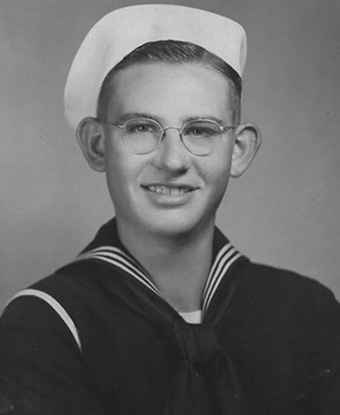Last updated: January 22, 2024
Person
Robert Lester Mundschenk

Courtesy the Mundschenk / Lull family in memory of Robert Mundschenk.
Robert Lester Mundschenk was born on June 6, 1924, in Boone County, Nebraska, specifically in rural Albion. The Mundschenks were blessed with nine children. Robert completed 10th grade then "worked out" on neighboring farms and ranches, like his older brothers. The five oldest bothers served in the war, and the two sisters moved to California to work in war production.
During the Depression the family moved to Keeline, Wyoming, a rather arid part of the state. From Robert’s brother Harold, we learned the family worked about 180 of the 640-acre farm. There was no electricity or indoor plumbing and the water was brought up from below ground by a windmill-powered pump. Horses were used to work the land. The family raised about 200 chickens and had dairy cows while outdoor cats and working dogs completed the menagerie. Potatoes and a vegetable garden were grown for family consumption, and they also produced a few grain crops to sell: wheat, corn, and oats. Modern amenities consisted of a Model A Ford sedan, and a hand-cranked radio on which dad, George, would listen to the news from a Denver station.1
Robert traveled south about 140 miles to Cheyenne to enlist. But he was only 18 years old, so he was not old enough to enlist without parental consent. His dad gave his consent and confirmed his date of birth in a telegram. On August 28, 1942, Robert signed up for four years of service, starting as an apprentice seaman (AS).
AS Mundschenk attended the U.S. Naval Training Station in San Diego, California for both his basic training and specialized training in the Machinist School. Upon graduating on February 5, 1943, he was promoted to fireman first class (F1c) and was granted leave for a quick trip home to visit his parents and two younger brothers.
F1c Mundschenk crossed the equator for the first time aboard the troop transport ship SS Mormacwren on March 13, 1943, earning the coveted status of a "trusty shellback." He was on his way to Pearl Harbor to join the crew of the USS Nashville and served aboard that ship from April 15 to September 27, 1943.
On September 30, 1943, he boarded USS Portland and headed back to California for destroyer training on Terminal Island. On December 31, 1943, F1c Mundschenk was received onboard the USS Cassin Young (DD-793), making him an original crewmember—a plank owner. He spent the next year and a half on Cassin Young, sharing boredom, laughter and danger with his shipmates as they served all over the South Pacific. Robert was promoted twice: February 1, 1944, to water tender third class, and November 1 to water tender second class (trainee) (WT2c(T)).
While on picket duty April 12, 1945, Cassin Young was hit by a kamikaze. WT2c(T) Mundschenk was one of the 59 men wounded. In addition to a scar on his neck, WT2c(T) Mundschenk received a letter of commendation signed by Fleet Admiral Chester Nimitz. The citation reads:
For meritorious service in connection with operations against the enemy while serving as Water tender in the forward fireroom of a United States Destroyer under heavy aerial attack by enemy forces on 12 April 1945 in the vicinity of Okinawa. After a plane and its bomb hit the foremast and exploded in the air above the forward fireroom holing stacks, uptakes, and decks and piercing many pipes and electric leads, he remained at his post in the fireroom as it filled with steam and gasses and assisted in securing the boilers and cutting off damaged lines and equipment and then assisted other personnel to safety before he himself left the fireroom. His courage and devotion to duty were at all times in keeping with the highest traditions of the United States Naval Service.2
USS Cassin Young was back on picket duty when it was hit again by a kamikaze attack on July 30, 1945. This attack took the life of 22 sailors, one of them a 21-year-old Wyoming farmer, WT2c (T) Robert Mundschenk.
In a letter addressed to Robert’s sister Wilma Mundschenk, Earnest Coyt Russell, whom Robert worked for on Cassin Young, described Robert’s actions during the first kamikaze hit:
…Shrapnel from the bomb penetrated the main deck and into the fire-room and a piece of shrapnel grazed Robert’s neck. He was not seriously injured and did not go to the Doctor for treatment until he had assisted in remedying damage to his station. Robert was that way always, never a murmur no matter how rough the situation.3
First buried in an American Military Cemetery in Okinawa, Robert was brought home in 1949 to be buried in Fort McPherson National Cemetery. His six brothers were pallbearers; all but the two youngest were in uniform.
Harold Mundschenk wants his brother Robert remembered as "a hard-working sailor." Harold and his son Kent agree that WT2c (T) Robert Mundschenk was a dedicated sailor who cared about others first.4
Footnotes:
- Family history gathered May 2020 from Harold and Kent Mundschenk, bother and nephew of Robert.
- Official Military Personnel File of Robert Lester Mundschenk, National Personnel Records Center, National Archives and Records Administration, St. Louis, MO.
- Quote from Russell letter: On behalf of the Mundschenk/Lull family in memory of Robert Mundschenk.
- Family history gathered May, 2020 from Harold and Kent Mundschenk, bother and nephew of Robert.
